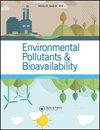正虹吸菌对不同铜和铅浓度的物理和抗氧化反应
Q3 Chemical Engineering
引用次数: 3
摘要
植物受到重金属胁迫后,其生理生化特性会发生改变。研究了正虹吸管对不同浓度Pb(0、2、5、8 mg/L)和Cu(1、2、4、5 mg/L)的响应。测定了水稻土壤重金属残留量、植株物理特性及抗氧化剂含量。结果表明,Pb浓度对茎伸长影响不显著,但在2 mg/L浓度下,Pb对叶片生长有促进作用。Pb浓度为5和8 mg/L时,植物总生物量增加。而5 mg/L Cu处理对玉米茎伸长和根长有显著影响。采后土壤中铅和铜的浓度显著降低。5 mg/L Pb显著提高了过氧化氢酶活性,而5 mg/L Cu显著降低了超氧化物歧化酶和抗坏血酸过氧化物酶活性。pb处理植株总黄酮含量升高,总酚含量降低。Cu浓度为2 mg/L时,总酚类物质含量增加。我们的研究结果表明,水稻o.s stamineus通过物理变化来适应金属胁迫,并通过酶和非酶抗氧化剂产生清除氧自由基。本文章由计算机程序翻译,如有差异,请以英文原文为准。
Physical and antioxidative responses of Orthosiphon stamineus towards various copper and lead concentrations
Abstract Plants normally change their physiological and biochemical properties when exposed to heavy metal stress. We investigated the response of Orthosiphon stamineus towards different concentrations of Pb (0, 2, 5, 8 mg/L) and Cu (1, 2, 4, 5 mg/L). Heavy metals left in soil, plant physical characteristics, and the level of antioxidants in O. stamineus were determined. Our results showed that the tested Pb concentrations did not significantly affect stem elongation, but at 2 mg/L, Pb increased the leaf growth. Pb at 5 and 8 mg/L increased the total plant biomass. In contrast, 5 mg/L Cu treatment affected stem elongation and the root length of O. stamineus. The concentrations of Pb and Cu in soil were significantly reduced after the plants were harvested. Biochemically, 5 mg/L Pb had significantly increased the activity of catalase, while Cu at 5 mg/L significantly reduced the activity of superoxide dismutase and ascorbate peroxidase. Total flavonoid content increased in Pb-treated plants, but the total phenolics content decreased. Cu treatment at 2 mg/L, on the other hand increased the total phenolics content. Our results demonstrated that O. stamineus adapt to metal stress via physical changes, and scavenge oxygen radicals through enzymatic and non-enzymatic antioxidant productions.
求助全文
通过发布文献求助,成功后即可免费获取论文全文。
去求助
来源期刊
CiteScore
1.62
自引率
0.00%
发文量
0
审稿时长
1 months
期刊介绍:
Chemical Speciation & Bioavailability ( CS&B) is a scholarly, peer-reviewed forum for insights on the chemical aspects of occurrence, distribution, transport, transformation, transfer, fate, and effects of substances in the environment and biota, and their impacts on the uptake of the substances by living organisms. Substances of interests include both beneficial and toxic ones, especially nutrients, heavy metals, persistent organic pollutants, and emerging contaminants, such as engineered nanomaterials, as well as pharmaceuticals and personal-care products as pollutants. It is the aim of this Journal to develop an international community of experienced colleagues to promote the research, discussion, review, and spread of information on chemical speciation and bioavailability, which is a topic of interest to researchers in many disciplines, including environmental, chemical, biological, food, medical, toxicology, and health sciences.
Key themes in the scope of the Journal include, but are not limited to, the following “6Ms”:
Methods for speciation analysis and the evaluation of bioavailability, especially the development, validation, and application of novel methods and techniques.
Media that sustain the processes of release, distribution, transformation, and transfer of chemical speciation; of particular interest are emerging contaminants, such as engineered nanomaterials, pharmaceuticals, and personal-care products.
Mobility of substance species in environment and biota, either spatially or temporally.
Matters that influence the chemical speciation and bioavailability, mainly environmentally relevant conditions.
Mechanisms that govern the transport, transformation, transfer, and fate of chemical speciation in the environment, and the biouptake of substances.
Models for the simulation of chemical speciation and bioavailability, and for the prediction of toxicity.
Chemical Speciation & Bioavailability is a fully open access journal. This means all submitted articles will, if accepted, be available for anyone to read, anywhere, at any time. immediately on publication. There are no charges for submission to this journal.

 求助内容:
求助内容: 应助结果提醒方式:
应助结果提醒方式:


